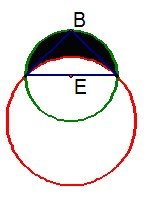- About MAA
- Membership
- MAA Publications
- Periodicals
- Blogs
- MAA Book Series
- MAA Press (an imprint of the AMS)
- MAA Notes
- MAA Reviews
- Mathematical Communication
- Information for Libraries
- Author Resources
- Advertise with MAA
- Meetings
- Competitions
- Programs
- Communities
- MAA Sections
- SIGMAA
- MAA Connect
- Students
- MAA Awards
- Awards Booklets
- Writing Awards
- Teaching Awards
- Service Awards
- Research Awards
- Lecture Awards
- Putnam Competition Individual and Team Winners
- D. E. Shaw Group AMC 8 Awards & Certificates
- Maryam Mirzakhani AMC 10 A Awards & Certificates
- Two Sigma AMC 10 B Awards & Certificates
- Jane Street AMC 12 A Awards & Certificates
- Akamai AMC 12 B Awards & Certificates
- High School Teachers
- News
You are here
An Investigation of Historical Geometric Constructions - Calculating the Area of a Lune I
What follows is Heath’s details of Eudemus’s description of Hippocrates’ method for calculating the area of one type of lune (see Figure 13 for an example of Hippocrates’ lune).
After proving this, he proceeded to show in what way it was possible to square a lune the outer circumference of which is that of a semicircle. This he effected by circumscribing a semicircle about an isosceles right-angled triangle and (circumscribing) about the base a segment of a circle similar to those cut off by the sides. Then, since the segment about the base is equal to the sum of those about the sides, it follows that, when the part of the triangle above the segment about the base is added to both alike, the lune will be equal to the triangle. Therefore the lune, having been proved equal to the triangle, can be squared. In this way, assuming that the outer circumference of the lune is that of a semicircle, Hippocrates easily squared the lune (Heath, 1921, pp. 191-192).
Figure 13: The area shaded in black is an example of Hippocrates’ lune.
Suzanne Harper and Shannon Driskell, "An Investigation of Historical Geometric Constructions - Calculating the Area of a Lune I," Convergence (August 2010)





